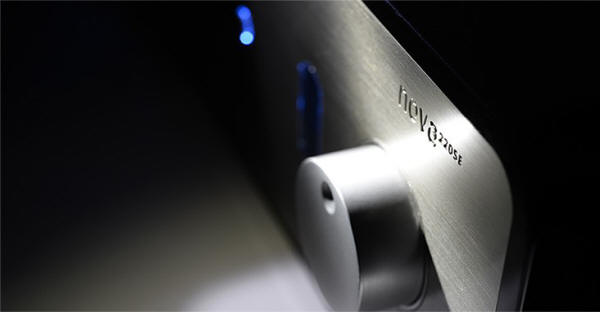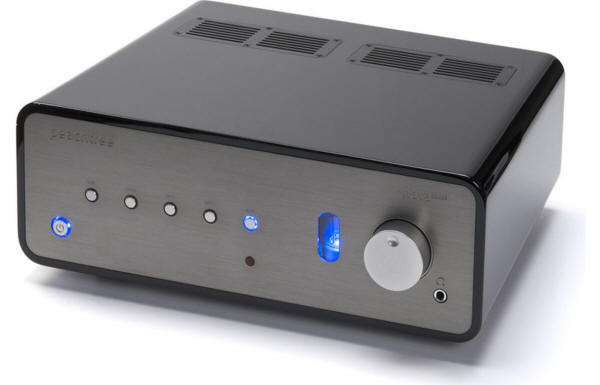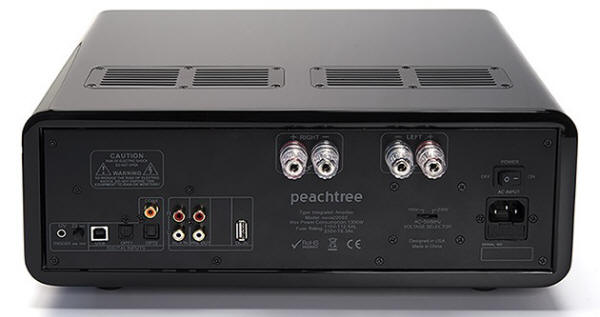The Neoteric Listener… The Peachtree Audio nova220SE Integrated
Amplifier
Four years ago, when some folks were worrying about WikiLeaks and toot-tooting their vuvuzelas, I spent two thoroughly enjoyable months listening to the Peachtree Audio iDecco integrated amplifier. At the time, I declared that the iDecco was the hands-down, no foolin', best option for anyone desiring a fast, thoroughly modern musical integrated for less than a grand. Paired with the impressive Nola Boxer standmount loudspeakers (another wonderful find), the iDecco was as sweet as a big plate of molasses cookies. A short time later, I upgraded to a new pair of Nola Contender floor standers. Flush from my recent experience, I opted for a Peachtree iNova. I assumed that the iNova's more sophisticated power supply with double the output of the iDecco would ramp up the good times––twofold. Bigger, bolder, better, yes? Nix, no, nope.. In my home, the iNova/Contender pairing has always been good, but never great, and has never matched the glory of the iDecco/Boxer system. Both amp and speakers shine with other review gear, but, sadly, never really hit it off as a couple. But now, just in time to rescue the Nola Contenders from forever waiting in a wedding dress for their beaux to arrive, the Peachtree Audio nova220SE crosses the threshold. Unlike the Nova and iDecco predecessors that employ a mosfet Class A/B design, the nova220SE depends on a Class D, dual-mono balanced stereo topology. I know what you're thinking. "Class D?! Isn't that for Home Theater and hearing aids?" Turns out, the crew at Peachtree Audio had the same Class D jitters. Jim Spainhour, product guru for Peachtree Audio, explains how they arrived at the decision to move away from Class A/B to the current design: "The larger and more sophisticated power supply in the iNova sounded better, hands down. But heat was a problem in our small case so we started looking at class D solutions. Initially we weren't very satisfied. Quite honestly we went in to the class D exploration kicking and screaming until we heard the ASX2 modules from Ice Power (B&O). They were an order of magnitude better than their previous modules and competitively priced. I'll never forget David Solomon calling me late one night after getting new samples saying 'Holy crap! They drive everything, even below 4 ohms, and they sound better than any Class D amp I remember hearing.' That's all I needed to hear…We use the 250ASX2 in the Nova125SE…125wpc in to 8 ohms and 250wpc in to 4 ohms."
Clearly, the Nova 220SE is significantly different than preceding Peachtree integrated amps. For starters, the 220SE's chassis is larger, and the iNova's cheery cherry wood (so suitable for shelf and alcove) has been replaced by a dark black polished wood. The 220SE also sports a new gray fascia that is similarly all-business. The result of these aesthetic changes is a product that commands respect from even the snootiest denizens of the audio rack. Gone is the ubiquitous iPod doc from the Nova line. The 220SE, however, retains such handy features as optical and coax digital inputs, a pure analog input, a headphone amplifier, a selectable triode tube buffer, and a high resolution DAC. Both the asynchronous USB and coaxial S/PDIF input can handle up to 24-bit/192Hz files, a big improvement over previous nova models. Another significant difference is the massive increase in power, a burly 220 watts per channel at 8Ω and 350 watts at 4Ω. Peachtree claims that "The better S/N and power specs give the SE products much better dynamics" than earlier nova models. Personally, I would prefer more RCA analogue inputs, but I do see the point of clearcutting a forest of interconnects to keep things simple and tidy. Clever packaging and straightforward design had things up and running in five minutes. I started things off by comparing my old iNova integrated to the new 220SE. To test the amps only, I alternated connecting my Audioengine D2 DAC to the Analogue input (via RCA jack) of each amp and played files from my Macbook Pro using Amara and Pure Music. Like most people who compare a new version with one they own, I was hoping that any difference would be negligible. Unfortunately for my wallet, the 220SE improved music sparkle and immediacy, and the reduction in low-frequency confusion was startlingly apparent. The Contenders obviously appreciated the powerful grip of the 220SE. There's no doubt everything sounded so much better because the drivers were working much more cohesively. The music just fell into place. Playing CDs with both amps merely confirmed the great leap of Peachtree progress.
A song like Goldfrapp's "Monster Love" serves well to illustrate the 220SE's many virtues. Wonderfully produced in the studio, the song is a beautiful aural fresco of synthesizer and multitracked vocals that gradually builds to crescendo and panning wide in the best early 70s rock fashion. The 220SE gives a warm, mesmerizing rendition of this song by offering an expansive soundstage and an absence of any sense of strain or harshness. There have been tube amps that may inspire more life and space in my Nola Contenders, but none have been so even and coherent across the board as the Peachtree Nova 220SE. Another illustrative track is Sarah Jarosz singing "Gypsy." A sumptuous reverie of accordion, guitar, and instrumental accents, her typically poignant vocal performance can sound edgy at peak moments. It is a credit to the 220SE that Jarosz's remains alluring without being abrasive. As previously mentioned, this Peachtree amp can muscle up nicely when called upon, as shown by the power and scope in its presentation of Junior Vazquez's remix of the classic rock staple, "Spill the Wine." This retake of the consummate musical bota bag is big on drama, drum machines, and cheesy synthesizer, but the louder you play it, the more it becomes monstrously silly fun. The joke's played out if there's not enough steam, though, and the fact that the 220SE has absolutely no trouble playing things loud and clean makes it a great integrated for those who still channel the animal within. Just for a lark, I played Wham's "Wake Me Up Before You Go Go" at club volume level. If this insipid round of British fluff inspires finger snappin' and grins all around, you know something's gotta be special about the playback. With the head-to-head integrated amplifier competition out of the way, I moved on to test the merits of the USB DAC. The DAC of the 220SE utilizes a new Sabre 9023 chip from ESS. In the past, I've always appreciated the effortlessness of Peachtree DACs that make listening so enjoyable. I admit, though, I usually prefer a more hard-hitting, resolving DAC signature, even if the price is occasional digital stridency. DACs, like many audio products, often sound better with each iteration, but they inevitably keep to the "house sound" of each respective manufacturer. The DAC in the 220SE improves on previous Nova DACs by increasing the depth and solidity of vocals and instruments. To be sure, a forensic tool for exploring the mix and minutiae of a recording, it is not. Armchair recording engineers may grouse about wanting more specificity, but I've found that all Peachtree DACs wear exceptionally well over time, and this newest version only improves on a time-tested winning formula for playing music files. Listening to The Church's "A Month of Mondays," the reverb drenched double-tracked vocals and accompanying instruments swirl about you with nary a moment's worry about pinpointing where and how the musicians weave the fabric. There's no ability to play DSD files, though, which is a drawback for me as I widen my collection, but perhaps not so much for others. Although DACs are definitely a matter of taste, I'd offer that, unless you have a very good standalone DAC already, you may find you don't need a better one than what's included in the 220SE. And, as a welcome option, Peachtree offers the BT1 Bluetooth Wireless DAC. For those of us who see it would be handy to occasionally play music from our phone, tablet or computer (without cables), be assured that the BT1 works flawlessly and sounds very nice, indeed. Not nearly as good as the 220SE's USB DAC, of course, but certainly fine and dandy for times when the absolute finest is not required. The Peachtree Nova 220SE is a splendid accomplishment for a company tremendously successful at capturing your attention without frightening your bank account. All Peachtree products sound good, but this amp is something special. I thought only tubed amps could make my Nola Contenders pucker up and blow, but the 220SE is an amp with universal appeal. Definitely recommended.
Peachtree Audio nova220SE Integrated
Amplifier
Peachtree Audio BT1 Bluetooth Receiver
|




